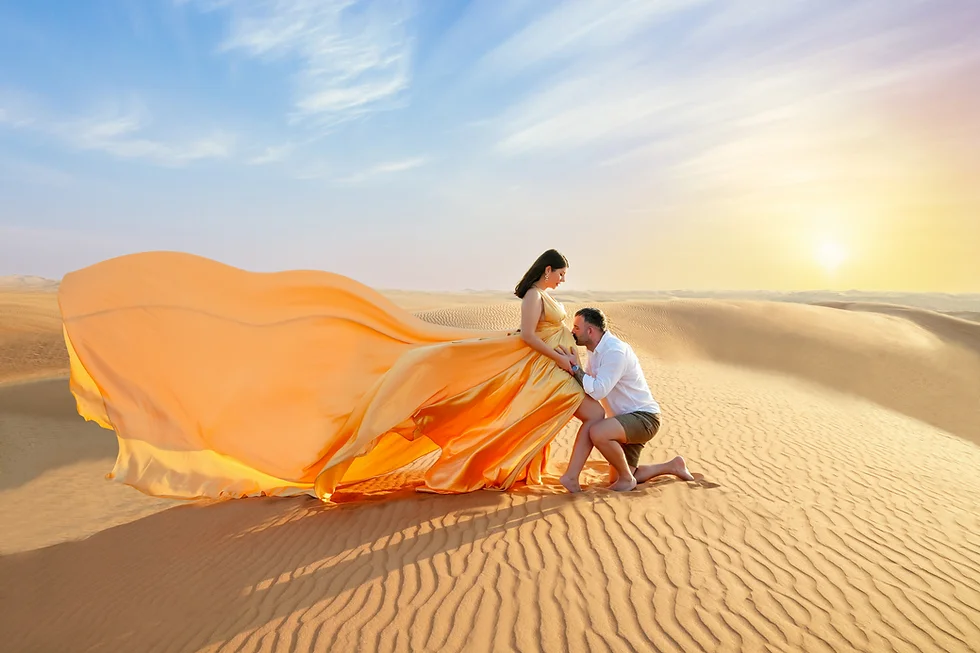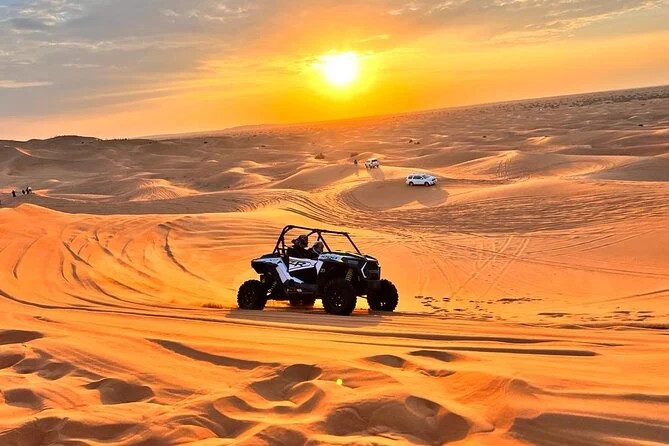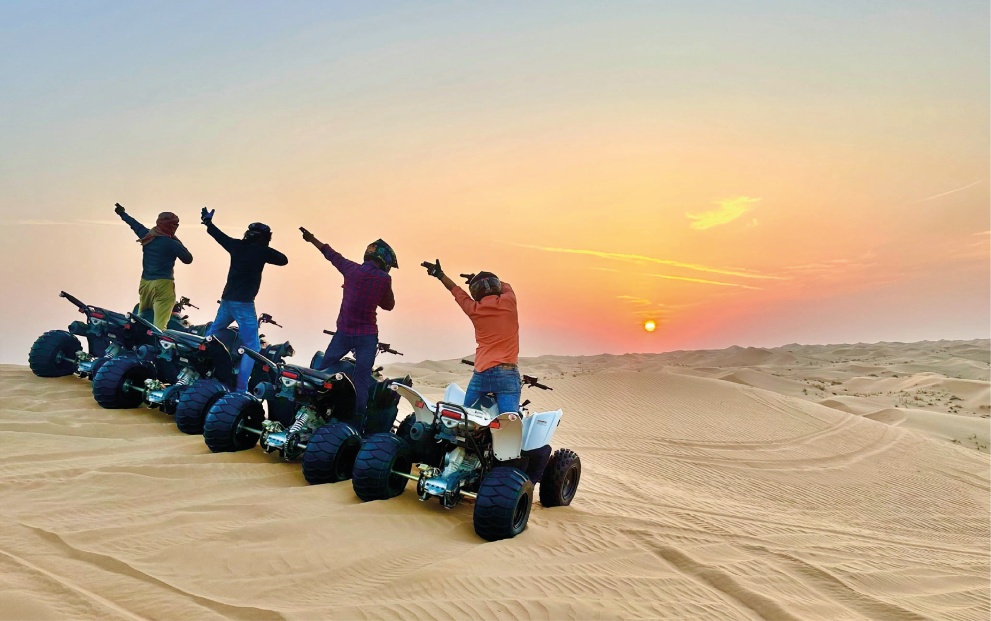Dubai’s Desert Photography:
Dubai’s sprawling desert provides photographers with striking colors, such as gold dunes, sharp shadows, and massive horizons. Whether you’re a candid or a DSL professional, transforming this natural wonder requires technique and imagination. Here are some photo-taking tips that could be of great help if you want to embrace the Arabian desert view in Dubai with Photography.
1. What is the Golden Hour?
Ideally, the photo in the desert should be taken at golden hour on your Dubai desert tour, which is just after the sunrise and before the sunset. The sun is low, hence shining straight on the camera Photography, making the sand warmer and forming long shadows. Have time to observe the standpoint, which is also perfect for photography, and be prepared for it as the lighting alters. The effect of diffused lights in this period allows for the avoidance of solid shadows, making the captured photos more balanced and exciting.

2. Use a Polarizing Filter
In desert photography, a polarizing filter is a beautiful gadget that is welcomed by photographers. It enables one to cut out the glare and reflections off the sand, deepening the colors and increasing the contrast between the sky and the sand. This filter can also help make the blue color of the sky more intense, and the clouds stand out, adding depth to the photo.
3. Lock in the Forms and Designs
The desert is especially rich in colorful and radiant patterns and textures that provoke the observer’s imagination. Search wind-blown sand waves, sand ripples, and blade-like shadows in the sand. By using the tele lens, we try to focus on these areas and produce abstract images. The application of light and shade can help convert ordinary scenes into excellent pieces of art. Try to capture the beauty of the desert and play with the focus to show a more artistic side of nature.
4. Play with Composition
About composing, care and focus are needed to communicate the vastness and the beauty of the desert. To produce well- proportioned and eye-catching pictures, follow the rule of thirds. By placing it lower in the picture, heavy concentration is given to the sky, and if placed high in the picture, the emphasis is put on expansive dunes. Use leading lines like trails or ridges that help lead the viewer’s eye through the picture plane and into the depth.
5. Include a Sense of Scale.
Describing the size of the desert can sometimes be rather tricky, and thus, it is critical to take an impactful picture. Add people, camels, cars, or any other object of a standard size so that you can compare them to the rest of the structures. It could be as simple as a man in the middle of the desert standing on the top of a dune or a convoy of camels crossing the vastness of the desert to give more importance to the picture. That is why the juxtaposition of two different things – small and immense – is so dramatic and meaningful when it comes to your images.
6. Embrace the Minimalism
Base – although contrary to some schools of photographic thought. The desert’s barrenness and lack of fuss is simplicity captured at its finest. Explain the feature of loneliness and solitude by accentuating figures and objects that are depicted apart from the others or recalling landscapes of deserts and steppes. It can help to give a calm atmosphere and bring more attention to the calm aesthetics of a deserted area. This is a perfect occasion for utilizing the negative space to attract the attention of the viewer to your main subject and create a feeling of tranquility.
7. Know the Right Weather to Expect
Sometimes, the climate in the desert may be extreme, so everything has to be planned for. Take off your shoes before entering the desert so as not to scratch. The sand onto your camera, and also avoid dropping the camera onto the floor. You should carry your camera and lens in a weather-sealed body or casing or a plastic bag if the above is not possible. Always ensure that you have a lens cleaning kit with you so that you can always clean the equipment. Drink enough water and wear an appropriate dress code for sun and heat. Another component that is important for a good camera is a strong tripod. Particularly in situations that require shooting at night.
8. Experiment with Night Photography
Night shooting is one opportunity clients can enjoy while in Dubai since it is a desert area. The condition of the atmosphere is also good, and this makes the area have obvious skies as most stars and other celestial bodies are well depicted. Try to avoid zoom lenses. Instead, the hand holds a wide-angle lens and a tripod for the long exposure shots. Photograph the Milky Way and star trails, or even use a flashlight to create a light painting. The painter also gets to paint the difference between the dark sky and the bright surface of the dunes, which may lead to otherworldly and enchanting work.
9. Utilize Drone Photography
Sharing some aerial shots is possible only with the help of drones, and such shots look great in the context of the desert. By using a drone, one is in a position to capture live videos that capture. The patterns and extent of the dunes. This shot was taken with pretty high ISO, but I can manage it. Because I shot the drone during the golden hour and got. These great long shadows and warm ocher tones of the desert. Always make sure to adhere to the regional laws and get the required permits before flying your drone. Try to get higher or at a different position to take wide-angle shots and more exciting and engaging views.

10. Incorporation of Wildlife and Flora
The desert may look like an empty and dull place. But it has its uses with so many animals and plants that bring life and excitement to your snapshots. Hopefully, there are some indigenous animals in the desert; places like the UAE are home to Arabian oryx, gazelles, and desert foxes. This is often desirable when you are aiming to produce photographs. That tells a story or depicts the subjects in their natural environment. Furthermore, the landscape of the desert is decorated with herbs and flowers. They are adapted to the tough conditions of the desert and look quite colorful and diverse in their forms. Another positive aspect of taking macro snapshots is the ability to give a new spin to a somewhat overdone subject. Desert plants.
11. Fix the whole motion and glide of Sand
Dune Buggy Dubai one of the most appealing features of the desert is the forms made by wind, constantly shaping the sand waves. To capture this form of dynamism, try out the long-exposure photography shooting technique. As sand is moving, the result should convey the idea of movement with the help of slow exposure time. This technique can produce somewhat surrealistic and highly symbolic images that will express the concept of the desert. As a place that is in a state of constant transformation. On the other hand, if you want the sand to be a primary subject of the photo to show that it was blown by the wind or is being kicked by moving objects, then freeze the action with a fast shutter speed.



